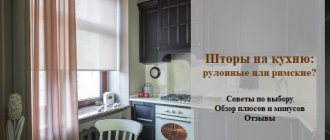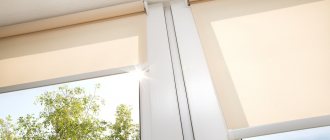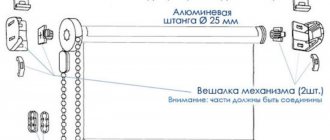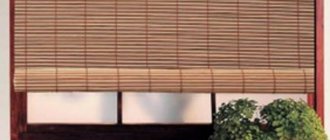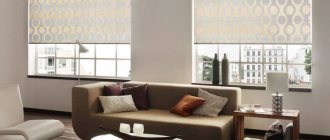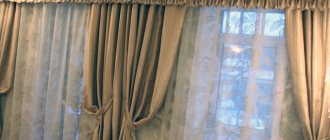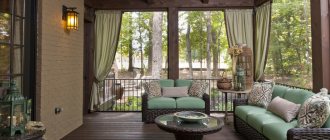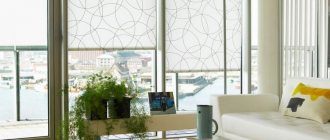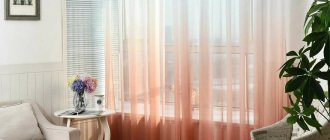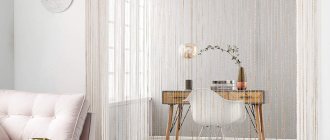We will give professional recommendations so that you can choose the best option based on the problems that need to be solved. We will provide assistance in selecting a roller blind model based on such criteria as light transmittance in percentage units.
To make the right choice, first determine the parameters of the room where you want to install roller blinds, such as light and humidity. So, if you need a product that has high light transmittance, it is recommended to give preference to ordinary curtains, which have high light dispersion rates. To achieve darkness, but to ensure that the material itself is transparent, it is advisable to choose light-absorbing products that can retain 80% of the sun's rays. And to achieve complete darkness, black-out curtains are an excellent option.
Features of light transmission
What does light transmittance mean? This is the amount of light that a material can transmit. The higher the degree of light transmission, the more light there is in the room when the curtains are closed.
The light transmission of roller blinds depends on the density of the selected fabric. As a percentage, it can be 50%, 80%, 100%. Complete darkness is created by the densest blackout fabric. It will appeal to home theater lovers, as well as residents of regions where there are white nights.
The peculiarity of blackout material is that the outer side of the curtains reflects not only light, but also heat. In the summer, this provides good relief from the heat and the apartment does not heat up. In cold weather, when there is no heating, the fabric prevents heat from leaving the room. It is worth purchasing thick curtains with low light transmission in the following cases:
- The need to get enough sleep during the day due to night shifts;
- The location of the apartment is on the sunny side of the house;
- White Nights;
- The location of bright lanterns and other lighting fixtures near the window;
- The light falling from the window causes glare on your computer monitor or TV.
Ordinary standard models diffuse light and create slight darkness. This solution is suitable for interiors where good lighting plays an important role. Light-absorbing materials block up to 80% of light.
What is blackout?
Blackout fabric (English blackout - darkening) is a modern material, which is a multi-layer fabric that absorbs light by 90-100%.
Blackout curtains consist of three layers:
- reflective, white, which is directed towards the window;
- the middle one, the thickest, has a high density and slows down the light flow;
- external, performs a decorative function and is available in a variety of materials and colors.
The wrong side of blackout curtains
The wrong side of blackout curtains
Light curtain with blackout pattern
Important! The color of blackout curtains does not play a role in light insulation. Therefore, they do not have to be dark and can have any design.
It is believed that blackout was invented in Finland, thereby solving the problem of sleep during the white nights. The material quickly gained popularity around the world due to its exceptional characteristics.
Hot pink blackout curtains in a teenage girl's bedroom
Other characteristics of roller blinds
The characteristics of the curtains are indicated in the product description. You can view them before purchasing and choose the appropriate option. Not only light transmission should be taken into account when choosing, but also many other nuances.
Also pay attention to:
- Material. Most often, curtains are made from high-quality polyester, but options with the addition of natural threads are possible. Remember that synthetics in this case are the best option. It does not fade, holds its shape well and blocks light.
- Mounting method. Curtains can be attached with self-tapping screws or adhesive tape. If you are not sure that you will not want to change this option to classic curtains, purchase curtains with adhesive tape. After removal there will be no holes left.
- Impregnation and thickness of the canvas. These factors also affect light transmission. The degree of repulsion of dust and dirt also depends on the impregnation.
Don't forget about the external design. The color and pattern of the canvas should be in harmony with the wallpaper, but not merge with it. So, for a room in Provence style, you can choose delicate shades and floral prints.
When choosing, pay attention to the information indicated in the model description. All questions can also be asked to a consultant.
The best natural fabrics
Silk, like all materials presented in the natural category, compares favorably with synthetics in terms of aesthetics. By the way, silk curtains are considered the most luxurious among the possible “natural” options, and not only due to their price: silk is an incredibly thin material, almost weightless and at the same time incredibly durable. Silk curtains are an elegant addition to any interior, impressive with their unique colors. Due to certain features, silk is suitable only for use in bedrooms/living rooms with windows facing north.
Advantages
- high strength;
- hypoallergenic;
- presentable appearance;
- does not lint.
Flaws
- fades in the sun;
- wrinkles;
- Hand wash only;
- quickly absorbs odors.
Atlas
Ideally even, glass-smooth fabric with moderate density has an elegant appearance and is famous for its ancient history. The material is not cheap and, to make it more accessible, other natural materials (cotton, viscose) or synthetics are added to it.
Advantages
- durability;
- wear resistance;
- high strength;
- hypoallergenic;
- does not accumulate static electricity.
Flaws
- stretches over time (in the presence of synthetic additives);
- the fabric is heavy.
Cotton
Inexpensive, practical and durable material, which is most often used to create curtains for residential premises. Several types of material are used in everyday life:
- chintz is the most budget-friendly option for cotton, often decorated with bright patterns;
- satin is an elastic fabric with a moderate satin sheen, retains its color well, and is easy to drape;
- mercerized options - special treatment gives the fabric a spectacular shine, unique texture, and immunity to the sun.
Advantages
- durability;
- ease of care;
- hypoallergenic;
- strength;
- does not accumulate static electricity.
Flaws
- color fading from the sun (inexpensive options);
- slight shrinkage after washing.
Wool
Woolen material can be either quite dense, with a fluffy texture, or surprisingly thin, smooth to the touch. Wool is a unique material with a special fine structure and pile that is the same in length.
Curtains made of wool actively absorb moisture, so you should be very careful when choosing such products for a particular room in the house.
Advantages
- does not wrinkle;
- weak soiling;
- pleasant to the touch texture;
- excellent heat capacity;
- elasticity.
Flaws
- the need for delicate washing;
- the likelihood of moths appearing in the folds of fabric;
- absorbs unpleasant odors (it is necessary to constantly ventilate the fabric).
Slightly rough to the touch, incredibly durable material with a unique structure. Ideal for rustic and eco-styles. The fabric has a high price, which is more than compensated by a lot of advantages. Linen, despite its dense structure, depending on the finishing features, can be used to create both dense heavy curtains and light openwork tulle. This is an excellent option for a child’s room or a spacious, bright bedroom.
Advantages
- wear resistance;
- weak soiling;
- hypoallergenic;
- does not fade in the sun;
- ability to pass air;
- high strength.
Flaws
- wrinkles a lot (and is difficult to iron);
- “shrinks” after washing.
How to choose roller blinds?
There are many options for roller blinds. You can choose a solution for any window and interior style. It is recommended to make roller blinds to order so that they fit perfectly under the window opening.
To choose the right curtains, use the following recommendations:
- If you are undecided whether you want complete darkness or light partial shade, pay attention to a variety such as “Day-Night”. The fabric of such curtains consists of alternating strips of translucent and very dense fabric. Using the adjustment mechanism, you can move the strips, getting either complete or slight darkening.
- Synthetics are optimal for any room. The addition of natural fabrics reduces the moisture-repellent properties, so such curtains are hung in rooms with low humidity.
- For bedrooms, it is better to choose the most dense materials possible. Absolute darkness promotes the production of melatonin and makes sleep sounder and healthier. For the kitchen, on the contrary, translucent materials are more often chosen, which, when closed, let in enough light, but hide the room from prying eyes.
Roller blinds transparent and translucent (darkening from 25 to 50%)
Sheer curtains can be compared to tulle. They do not protect the premises from the penetration of most of the sun, but at the same time the room will be hidden from prying eyes. This option goes well with curtains; they are also suitable for rooms where darkening is not required. As a rule, they are chosen for windows that face the east and southeast sides.
The darkening capabilities of translucent curtains are much higher than those of transparent curtains. They provide light filtering of light. This solution would be optimal for an office.
Selecting roller blinds based on light transmission
When purchasing, you need to determine in advance the degree of illumination and humidity of the room where you plan to install roller blinds, as well as its location and interior:
- If you need to choose curtains with high light transmittance, then you should pay attention to ordinary models; they diffuse light perfectly.
- If you want to get an eclipse effect with the transparency of the material itself, opt for light-absorbing curtains; they can block 80% of the sun's rays.
- If the room needs absolute darkness, then completely darkening (black-out) options are suitable.
Fabrics
Since it is the quality of the fabric that affects the density of the curtains, it is worth talking about the material separately. Let's look at the most popular types of fabrics that are used to create blackout curtains, as well as their features.
- Cotton. This natural fabric can have different densities. Its main advantage is that it is a fairly durable and wear-resistant material that serves its intended purpose for a long time. Cotton curtains can be neutral colors or dyed. However, over time, the paint may fade, especially if your windows face south and the material is constantly exposed to the sun.
In order for cotton curtains to maintain their beautiful appearance longer, they need to be properly cared for. Wash them without bleach if possible, and straighten them well when drying.
- Linen. Another high-quality natural material that is used to create curtains is linen. This fabric is more dense and even stiffer.
The main disadvantage of the material is that all the folds and irregularities are visible on it. Therefore, it is better to buy linen blinds with lining. It is needed because the fabric fades very quickly in the sun.
- Silk. If you need a fabric that does not wrinkle, then you should pay attention to silk. This is a fairly expensive material that is sensitive to temperature and high humidity. But, of course, it also has the advantage of a beautiful appearance.
Silk curtains are most often used to decorate bedrooms or living rooms where you want to create a luxurious atmosphere.
- Wool. Heavy and light-proof curtains can also be made from wool. The good thing about sheepskin is that it makes very elastic curtains that absorb all the noise from the street.
They should only be washed by hand in warm water. They cannot be soaked in water for a long time, and in general you need to be extremely careful when handling such material.
- Synthetics. You can also get dense, heavy fabrics from synthetics. Such curtains can be completely synthetic or made from natural fibers mixed with synthetics .
The good thing about artificial fibers is that they make natural fabric easier to care for and more elastic.
Among synthetic curtains there are different material options. Firstly, it is polyester - a very durable, but at the same time soft fabric. It looks good on the window and does not wrinkle. You can also pay attention to viscose and acetate.
- Brocade. Curtains made of brocade look expensive and beautiful. This material is based on a combination of the two already mentioned above - cotton and natural wool. This fabric is often complemented by a voluminous pattern.
Most often, the top of the window is draped with similar material, while classic curtains made of thinner fabrics are hung below.
- Chintz. This fabric has a beautiful shiny texture. A special composition is applied to its surface to impart this same shine.
Chintz curtains can be either plain or decorated with different patterns. Such products pleasantly please with their density, since they do not wrinkle at all.
- Damascus. Damascus curtains can be matte or shiny. To create damask fabric, a combination of wool, cotton and silk is used. All these fibers, combined with each other, look very impressive. Damascus is used to create beautiful curtains and blinds.
- Atlas . Another type of shiny fabric. The back of these curtains has a pleasant matte finish, while the outer part has a beautiful shine.
Long products from the ceiling to the floor, made of satin, look best.
- Taffeta. This is a tough material. On the one hand, this is an advantage, and on the other, a disadvantage. Curtains look voluminous and lush. The material shines, but does not match all interiors.
- Velvet. Along with satin and brocade curtains, velvet curtains also look luxurious. The slightly fleecy surface quickly collects dust, but at the same time, such curtains are quite easy to care for.
Of course, this is not the entire list of fabrics. You can find other options if you browse the selection at many stores.
Types of curtains that block light
There are the following types of light blocking curtains:
Let's look at them in more detail.
Blackout
The word “blackout” translated from English means “darkening.” This is what they call curtains that are 100% light-proof. It is believed that they were invented in Finland, since in part of the country there are white nights for 3–4 weeks a year.
From the street it is impossible to understand that the apartment has blackout curtains due to the light coating on the outside. And no light penetrates into the home.
They are able to reflect heat, so they protect from the summer heat. The opposite effect also works - blackouts maintain the temperature in the apartment during the cold season.
The entire product is sewn from light-proof fabric or used as a lining between layers of another material that looks more attractive.
Blackouts help you fall asleep in bright conditions (for example, during the day, during a white night). But it’s harder to wake up with them.
Dimout
Dimouts block at least 80% of the light. Suitable for protection from bright advertising banners and street lamps. Dimout is hung in the kitchen and living room.
Sometimes they try to sell such curtains under the guise of blackout curtains, which cost more. Therefore, you need to be careful when purchasing.
Blackout curtains
Such curtains are made of thick fabric, so they are cheaper than blackout or dimout. They are used according to the situation - on a sunny day they are covered, in low light conditions they are opened.
Plus - a large selection, thanks to which you can choose a curtain to suit any interior, the ability to sew it to order.
The downside is incomplete light protection. Dense fabric blocks no more than 40% - 50% of sunlight or light.
Roller blinds
Curtains made of thick material, collected in a roll located above the window. They transmit less light than dense ones. Not suitable for all interiors.
Blinds
They provide light protection at the dimout level, as they are made of dense polymer material. The downside is the “office” look, which is not suitable for living space.
What are you working on now?
I have roller blinds on the sunny side - they save me in the heat
Interesting article. A lot of useful information. As an experienced curtain maker, I’ll add. Modern Blackout and Dimout fabrics are not what you've probably seen in hotels in the south - a rubberized base that also smells in the bright sun. These are fabrics of different shades, with patterns or different textures. You can use such fabrics as independent window decoration, without the use of curtains. Not what was common before - curtain fabric with an opaque lining plus tulle. The curtain rod had to be designed for the heavy weight of the curtains. Now the darkening fabrics do not stand up, they can drape freely. As for other dimming systems, these are the roller blind, which the author of the article talked about, and pleated ones. Such systems have different percentages of opacity, as well as different designs and shades. They are mounted both on the frame and in the window opening, and above the window, and in the ceiling. Roller blinds look more office-like, but pleated blinds are an interesting addition to textile interior design. There are several catalogs from different companies - there you can choose the desired design. The choice is huge. And in such systems there is a “day-night” option. Can be done manually or electrically.
Someone with experience may be able to tell me: I’ve seen pleated plastic blinds INSIDE a double-glazed window in Europe! The pleats are folded and placed between the glass (horizontally), controlled by two strips with magnets - they are applied directly to the inner glass and you move it - you want it from below, you want it from above. The pleated glass, located inside the double-glazed window, also has either two magnetic strips or two metal strips (on top and bottom of the pleated glass) - they are attracted to the inner glass from the inside. I need such a solution, but I can’t find it in our vastness. maybe I'm looking in the wrong place?
Combinations
To reduce light transmission, curtains are combined. The following types of combinations are used.
- Thick curtains and tulle. Collectively thicker than one curtain. Retains 40% - 60% of light (depending on the material and density).
- Curtains and roller blinds. Provide protection from bright light in different conditions. Rolls provide almost complete darkness. Curtains let in more light, making them suitable for cloudy days.
- Blackout and roller blinds. Blackout is suitable for summer as it does not allow heat to pass through. Roller blinds - for other seasons or cool weather.
For different seasons
- For the autumn-winter period, dense, rough fabrics in dark shades are suitable. It is better to refrain from bright patterns. Multi-layering will look good. For the spring-summer season, light, translucent materials with ornaments are chosen. In summer, in a room where there is little sun, you can leave only tulle.
Correctly selected curtains can do a lot: visually expand the space and add volume, create a unified room style and the right atmosphere. By following the above recommendations, you will know exactly which curtain fabrics to choose.
When to change the light transmittance of curtains
Light transmission is changed in the following cases:
- the TV or computer screen glows, glare appears, but there is nowhere to move the equipment;
- at dawn, the sun's rays penetrate the house or apartment, as the windows face east;
- near the house there is a street lamp, a bright advertising banner, and other light sources;
- the owner of the apartment lives in a region where white nights occur, making it difficult to fall asleep;
- I have to sleep during the day because I work the night shift.
Cotton curtains
Cotton material differs from most analogues in its high strength and environmental friendliness. They can be plain or with a pattern applied to the surface by printing or painting. Despite its widespread use, cotton has a number of disadvantages, namely fading and loss of color over time. It is not recommended to use cotton curtains on windows on the west and south sides of the house in strong sunlight, because the material, despite its strength and wear resistance, is weak to UV rays. With prolonged contact with sunlight, the area exposed to ultraviolet radiation begins to fade.
It is possible to avoid this drawback by making a special lining, which will not only protect the material from fading, but also serve as an additional layer between the sun’s UV rays and the room. Loss of color over time can be prevented if you use delicate laundry with appropriate powders and conditioners. The delicate washing mode implies not only cool water, but also a minimum speed, so as not to damage the fabric during the washing process.
Helpful advice! When hanging on a line to dry, cotton curtains should be straightened to reduce ironing problems. It is best to iron small folds of wrinkled fabric using the steam mode.
When you don't need to change
The light transmission of curtains is not increased in the following situations.
- When you need light to enter the room. For example, due to interior features.
- If the main function of curtains is not to block the sun's rays, but to protect the room from the views of strangers.
- Due to the peculiarities of the pattern of the curtains. Some patterns only reveal themselves when the sun's rays shine through.
- In low light conditions. If the apartment is located on the ground floor or near trees, light has difficulty penetrating there. In this case, the curtains should have more light transmittance.
The permeability of curtains determines how much light the curtain lets in. It is increased when complete darkness or protection from sunlight is needed (for example, if the TV screen or computer display is reflective). Based on light transmission, curtains are divided into blackout, dimout, and thick. The first do not transmit light at all. The latter retain 40% - 50%.
Color solutions
There is even greater variety in terms of colors and prints. Depending on the color of your room, you can choose darker or lighter curtains.
The simplest and most neutral colors are white, beige, and coffee. You can also choose beautiful colored fabrics: pink, burgundy, blue.
The main thing to consider here is how well the color of the curtains combines with the color of the wallpaper or other fabrics in your room.
To learn how to choose the right curtain color, watch the following video.
Textiles for making roller blinds
For the production of roller blinds, 9 main types of materials are used:
- Polyester. Practical material, perfectly reflects and absorbs sunlight, has antistatic and dust-repellent qualities.
- Adding viscose allows you to get a fabric with an interesting structure.
- The material with the addition of cotton is distinguished by its durability and good shrinkage. But it is not recommended to use the canvas in rooms with high humidity (bath, kitchen), otherwise the material may become deformed.
- As a result of the unusual combination of polyester and satin, the fabric has an attractive shine, but the material may shrink slightly with use.
- Adding acrylic. A thin layer of acrylic coating gives the material softness and helps maintain its shape.
- Fiberglass with polyvinyl chloride. It is durable and resistant to high temperatures, which allows the fabric to be used even in saunas.
- Linen with cotton. The combination looks very interesting, perfect for houses with a rustic flavor.
- Opaque textiles. Fibers made from a special material do not allow sunlight to pass through. But with sudden temperature changes, the side edges of the fabric may bend.
- Scorched fabrics. Acids are used when processing the material. This allows you to get a high-quality and beautiful canvas. The most effective and expensive option.
Rating of the best fabrics for curtains
| Nomination | place | Name of product | RATING |
| The best natural fabrics | 1 | Silk | 4.9 |
| 2 | Atlas | 4.8 | |
| 3 | Cotton | 4.7 | |
| 4 | Wool | 4.7 | |
| 5 | Linen | 4.6 | |
| The best artificial fabrics | 1 | Viscose | 4.9 |
| 2 | Polyester | 4.8 | |
| 3 | Acrylic | 4.7 | |
| 4 | Nylon | 4.6 | |
| The best mixed fabrics | 1 | Blackout | 4.9 |
| 2 | Taffeta | 4.8 | |
| 3 | Jacquard | 4.8 |
Light-diffusing and reflective fabric: what's the difference?
Curtain materials with low light transmittance are divided into two types:
The principle of operation of these materials is fundamentally different, and they are used in different conditions. Let's look at how these types of curtains work and which one should be purchased in which situation.
Light-diffusing fabric
Light-diffusing textiles are widely used in the manufacture of advertising signs. It is called backlit. This is due to the design features of the fabric - literally backlit means “lined at the back”. The material has a special polymer coating located on its back side.
The principle of operation of the material is light scattering. In practice, this means that the curtain does not block it completely. But thanks to the layer made of polymer, it dissipates it as much as possible and breaks it down. Thanks to this, light practically does not penetrate into the room.
The best artificial fabrics
Viscose
A synthetic material made from natural cellulose, and often passed off by unscrupulous sellers as natural fabrics (le, cotton, wool) due to its similarity to them. It is difficult to imagine how a high-quality soft material can be created from wood, and yet it is possible.
Viscose textiles are incredibly in demand, which is explained by a number of properties of this material, pleasant to the touch, attractive in appearance and safe for the human body.
Advantages
- aesthetic appearance;
- does not generate static electricity;
- easy to drape;
- ease of care;
- ability to pass air.
Flaws
- fades in the sun (not all products);
- loses strength when wet.
Polyester
Polyester has incredible fiber strength. He owes this to the rapidly developing textile industry in the 30s of the 20th century, which was looking for new practical materials.
The properties of polyester fibers are so unique and varied that it is used not only in the manufacture of curtains and clothing, but to create toys and even winter clothing insulation.
Surely many have heard of polyester, but under different names. Manufacturers often use the following on labels: lavsan, dacron, diolene, etc. The material is used extremely rarely in its exclusively pure form - a mixture of synthetics and natural fibers is almost always added to it. It is not advisable to use polyester to decorate the windows of a bedroom and children's room, but for other rooms it is ideal.
Advantages
- wear resistance;
- strength;
- resistance to pollution;
- immunity to sunlight;
- ease of care.
Flaws
- sometimes causes allergies;
- poor breathability;
- rapid accumulation of static electricity.
Acrylic
One of the few synthetic materials that can compete with natural ones. Despite its completely artificial origin, acrylic is absolutely safe for the human body, has a presentable appearance and will fit into almost any interior.
Advantages
- hypoallergenic;
- durability;
- aesthetic appearance;
- ease of care.
Flaws
- poor breathability;
- accumulation of static electricity;
- change in structure under the influence of sunlight (becomes hard).
Nylon
One of the most sought after types of fabric in the world. Created by complex polymerization of raw fibers, the finished material is incredibly thin, durable and soft to the touch. By the way, nylon in its pure form does not stretch, so lycra is added to it. In appearance and to the touch, nylon curtains are very reminiscent of silk: the same delicate smooth texture. Being completely synthetic, the material is incredibly valuable for its versatility.
Advantages
- high strength (in this indicator, silk, for example, is 2 times inferior to nylon);
- wear resistance;
- low maintenance (the fabric can be washed even in cold water);
- lightness (nylon is lighter than silk).
Flaws
- low breathability;
- rapid accumulation of static electricity;
- causes allergies.
Manufacturers
Light-protective curtains are produced by domestic and foreign companies.
- Master (Russia) produces light-protective roller blinds from fabric canvas and blackout. Photo printing techniques are widely used. Lifting mechanisms made in Holland. The electric drive is equipped with a remote control.
- Velux (Denmark) specializes in the production of skylights and Siesta blackout curtains. Canvases can be used not only in attics, but also in ordinary bedrooms, living rooms or children's rooms. "Siesta" darkens the room 100%. The company's assortment includes 40 colors of this model. The light-proof curtain for the window is made of polyester. It is dirt resistant and easy to maintain. The aluminum coating on the back of the model provides good thermal protection. The simple design can be installed in a few minutes (Pick&Click system).
- Roto (Germany) produces RotoStandart roller blinds with an aluminum layer that reflects heat and light. The products are mounted on the frame without a gap, which enhances the light-protective properties of the models. The curtains rise smoothly and are fixed in three positions. The canvas is impregnated with a substance that provides resistance to light and ease of maintenance. RotoStandart is made from 3 materials, in 37 different colors.
- The Turkish company Apolena produces light-protective curtains for the living room and bedroom. The collection includes plain products and models with patterns of rich colors, made of 100% polyester.
Light-protective curtains calm you down and give you a long, sound sleep. They create a romantic atmosphere and prevent glare from TVs and monitors. This is the textile item that takes care of our well-being and comfort.
© 2021 textiletrend.ru
Incorrect curtain length
Problem
Having calculated the length of the curtains according to the height of the window, you may discover during the hanging process that the curtain is too short - you forgot about the cornice. And if you take a large supply, the edge of the curtains will lie on the floor.
Yes, it’s so fashionable now, but just imagine how inconvenient it is in everyday life: the folds need to be constantly straightened, if you move and open the curtains during the day and night, the long edge attracts pets and collects dust and fur.
Solution
To the window sill:
the bottom edge of the curtain is 1 cm above the window sill - the fabric can be moved freely.
Below the window sill:
curtains look neater if they hang 10–15 cm below the window sill.
To floor:
curtains end 1 cm above floor level to reduce wear and tear. You can also choose the length of the curtains so that the fabric falls to the floor.
INMYROOM Tip:
to determine the length of the curtain, measure the distance from the cornice or rail to the expected position of the curtains below.
How to make the correct measurement?
When installing roller blinds inside a window opening, measure its width and height: the width of the product should be 4 cm less than its dimensions. Measurements of the height of the roller blind are made so that it is 2 cm less than the height of the opening.
When installing light filters on a wall or ceiling, you need to measure the width and height of the opening, adding 8-10 cm to these values. If the window is located in the same plane as the wall, you need to use special brackets that protrude the required distance from it. The width of the canvas will be equal to the width of the opening, increased by 20 cm (10 cm on the left and right).
If installation is carried out on sashes, you need to measure the width of the glass and add 3 cm to it. This will be the width of the curtain. When taking measurements, calculate the position of the canvas so that it does not interfere with turning the handle. Installation of UNI type systems is carried out according to measurements of the transparent part of the window, i.e. in width and height between the glazing beads.
Why do you need protection from light?
Light-blocking curtains can be useful in the following cases.
- If the bedroom windows face east, and the morning sun wakes up the owners of the house long before the alarm clock.
- If you live in northern latitudes, and a day that lasts six months does not allow you to get enough sleep.
- In conference rooms and business centers, where presentations are accompanied by slides or films.
- In schools, colleges and universities, if educational films are shown during a lesson or lecture.
- In medical institutions where complete darkness is required to make a diagnosis.
- In nightclubs and cinemas.
- In photo laboratories, so as not to expose the film or print high-quality photographs.
